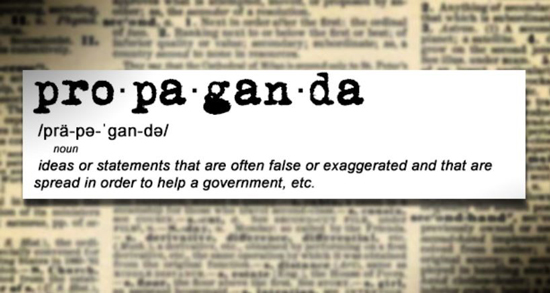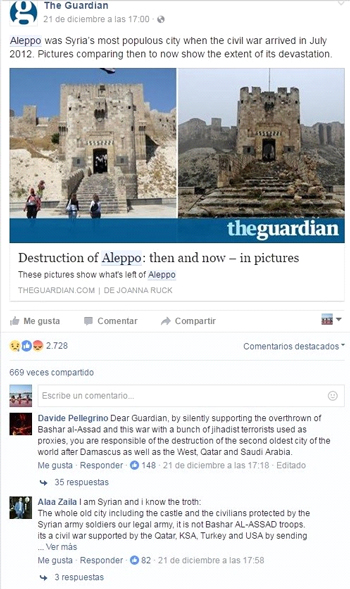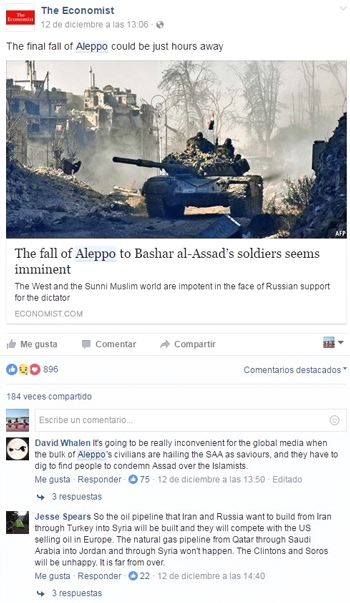From Official Policy to Mainstream Discourse: Propaganda in The Making

The Countering Disinformation and Propaganda Act (CDPA), passed on December 8th, 2016 by Barack Obama, was first presented to the US Congress on March 16th. This effort in information warfare was in the making long before the mainstream media campaign against “fake news” – or serious allegations of Russian meddling in US elections – started. This is an analysis of how foreign and domestic policy becomes “popular demand” through mainstream media.
It was November 24th when Craig Timberg from the Washington Post ran a piece about the “findings” of an anonymous media analyst called Propornot, blacklisting nearly 200 alternative news sites as peddlers of “Russian Propaganda”. After a strong negative reaction by many journalists, the Post issued a correction stating that the newspaper didn’t endorse the findings made by Propornot. A week later and despite corrections, Timberg followed up his piece on “Russian Propaganda” with the article Efforts to Combat Foreign Propaganda Advances in Congress, where he states:
“Congressional negotiators on Wednesday (November 30th, 2016) approved an initiative to track and combat foreign propaganda amid growing concerns that Russian efforts to spread ‘fake news’ and disinformation threaten U.S. national security”, and further into the article: “The initiative grows out of a bill authored in March by (Sen. Robert) Portman (R-Ohio) and Sen. Chris Murphy (D-Conn.) called the Countering Foreign Propaganda and Disinformation Act. It initially sprang from a desire to help independent journalists and nongovernmental organizations in European nations such as Ukraine, Moldova and Serbia, which face a heavy tide of Russian propaganda.”
This information is misleading. In reality, the initiative didn’t “grow out” of a bill authored in March; instead, the initiative and the bill are one and the same. It was lightly modified in July 2016 to eliminate a small paragraph on Ukraine, included in the first place mostly as an example of the kind of situation it would address. The article is also based on information judged as doubtful by its own editor, to say the least. After the July version of the bill, there were no further modifications.
But by July, both “fake news” and “Russian propaganda” were only beginning to surface in mainstream media as a trending topics (and national security concerns). We cannot imagine a positive or welcoming reaction to Obama’s sanctions against Russia – or the need to regulate Facebook – if they would have been presented to public opinion by July or even September. But for Sen. Rob Portman, the urgency of the problem was clear enough when the Act was introduced for the first time in March, as he stated in an Atlantic Council speech:
“Structural deficiencies are preventing us from effectively countering foreign disinformation and propaganda and will continue to hinder future administrations – both Republican and Democrat – unless they are addressed…
The most sophisticated media engagement strategies in the world will not work if the adversary jams communications towers, censors media outlets, or pursues a comprehensive strategy of grassroots manipulation designed to shape perceptions on the ground…”
The “agenda setting” media, with the Washington Post leading the effort this time, was only preparing itself to start the propaganda campaign that then gained momentum with the presidential election itself, and basically repeated Portman’s view of foreign propaganda adding the already mentioned examples of the threat –Russian sponsored “fake news” and propaganda – supported by intelligence “consensus” and supine, dishonest analysis.
This is the usual methodology when incorporating regressive policies or engaging in military aggression, only subtly dressing them as national security measures: the political establishment decides the policy, if popular support will be needed or the issue at hand is controversial, a few months before presenting it publicly a propaganda campaign will convince the audiences of the urgency and legitimacy of the law, sanctions or military measures taken.
We saw this pattern repeating itself time after time in the last decade and a half with Iraq, Libya or Syria, but it might be as old as propaganda itself. “Regime change” during the Cold War was said to respond to the Communist “threat”, and alternative discourses were many times labelled “anti-American”, a mere form of censorship. Now it’s “fake news”.
To be clear, the CDPA itself could have passed without much noise, as it was inserted in the National Defense Authorization Act for 2017, and passed quietly at night, during holidays. The propaganda campaign discussed in this article was aimed mainly at convincing the public about a dangerous enemy country meddling in US democracy by malicious, covert means, which also served to divert attention from the contents of Hillary Clinton’s campaign leaks, with its embarrassing revelations of the campaign’s ties with journalists.
Finally, it was vital in substantiating further measures taken by Obama, as the expulsion of 35 Russian diplomats. The outgoing administration is clearly stating that Russia, and particularly Putin, are enemies of the US and the President should continue to consider them so, or be called a traitor “anti-American”.
“In his dalliance with Vladimir Putin, Trump’s actions are skirting treason… By undermining further investigation or sanctions against the Russian manipulation of the 2016 election, Trump as president would be giving aid and comfort to Russian interference with American Democracy”, said democrat Robert Kuttner.
In other words, the propaganda campaign served both to pass the CDPA without opposition, establishing an information regulatory body aimed at the need to “shape perceptions on the ground”, as Portman pointed out to his elite colleagues in the Atlantic Council in March 2016, and to legitimate Obama’s harsh sanctions and vilification of the Russian government. The Propornot “fake news” fiasco served to toss dozens of alternative media news outlets into the equation and create distrust for them and for social media’s recklessness when addressing the issue.
It is fundamental to note that any authoritative voices against the CDPA or the smearing of Putin were absent from mainstream media, which framed the supposed hacking, “fake news” and Russian propaganda as a real, malicious and even blatant attempt by Russia to put a “stooge” in the White House and manipulate the American democracy. Other voices and testimonies involved were not part of the “plurality” of the world’s mainstream media, as Craig Murray, former UK ambassador, who declared that the supposed hacks were actually leaks given by a democrat insider after the Bernie Sanders boycott. As a member of WikiLeaks and directly involved in receiving the information, we would think he had something to say that would interest Washington Post readers. Letting opposite voices have their say is elementary journalism.
We can now add a second “fake news” fiasco by the Washington Post, alleging without proof that the Russians hacked and manipulated the US electric grid and then retracting a day later. Of course, the damage was already done and the “scoop” went viral. In terms of propaganda that’s a mission accomplished. Again, there is nothing new to see here, if we remember the San Bernardino Shooting in December 2015, the New York Times declared “terrorist ties” to the perpetrators without solid proof, to later acknowledge that a “Systemic Change is Needed After Faulty Times Article”. Again, the effect was already out there, going viral: the US was “under terrorist attack”, or “ISIS is not limited to the Middle East, it can kill you in any American neighborhood”.
Example: this is a tweet of the Washington Post “fake news” that was retweeted thousands of times, posted by New York Times editorial writer Brent Staples.

Glenn Greenwald made an excellent point regarding the Washington Post and fake news in a recent piece for The Intercept:
“Whether the Post’s false stories here can be distinguished from what is commonly called ‘Fake News’ is, at this point, a semantic dispute, particularly since ‘Fake News’ has no cogent definition. Defenders of Fake News as a distinct category typically emphasize intent in order to differentiate it from bad journalism. That’s really just a way of defining Fake News so as to make it definitionally impossible for mainstream media outlets like the Post ever to be guilty of it (much the way terrorism is defined to ensure that the U.S. Government and its allies, by definition, ever commit it).”
How Facebook Changed the Game for News Sources
Facebook, specifically, is another main concern in the “fake news”/propaganda discourse, as it was becoming “…the most powerful force in the news industry”, according to Farhad Manjoo in a New York Times report, in June 2016. Another August 2016 piece by the Times, called Inside Facebook’s (Totally Insane, Unintentionally Gigantic, Hyperpartisan) Political-Media Machine, was probably one of the first to point out the supposed dangers of Facebook as a news outlet:
“Facebook’s takeover of online media looks rather like a slow-motion coup. Before social media, web publishers could draw an audience one of two ways: through a dedicated readership visiting its home page or through search engines. By 2009, this had started to change. Facebook had more than 300 million users… By late 2012, when Facebook passed a billion users, referrals from the social network were sending visitors to publishers’ websites at rates sometimes comparable to Google…”
In other words, audience attention was shifting from mainstream media and traditional news sources to independent sites and blogs, which amounts to a “coup”, as Facebook popularity was being abused by bastard, non-corporate news outlets to gain instant massive audiences. This means an obvious loss in advertising revenue. It’s all about where the attention of the masses is, in terms of revenue, but it is also who they listen to, in terms of propaganda.
Certain political discourses are traditionally disseminated by the mainstream media because of its corporate nature and shared interests, and Facebook was opening the door to non-corporate and independent/alternative news sources presenting different narratives. These alternative media weren’t new, but Facebook made them more accessible to a population that has become increasingly incredulous of traditional media.
Of course, this isn’t the perspective of liberal media like the Guardian, where Olivia Solon reveals one of the possible solutions in an article in November 2016, adequately called Facebook failure: did “fake news” and polarized politics get Trump elected?:
“…Facebook could introduce a mechanism to allow fact checking organizations to report false stories to Facebook so they don’t continually circulate. ‘Of course, people will shout censorship, so maybe Facebook could choose to change the way it displays certain stories instead’, she (Claire Wardle, research director at the Tow Center for Digital Journalism) said.”
Understanding the Syrian conflict amid Facebook’s informational “coup”
The Syrian conflict pictures this “coup” rather clearly: mainstream media’s narrative had to compete with a very different perspective brought online by independent researchers and disseminated via social media to reach millions, who then started making questions, and demanding the same quality of coverage from mainstream sources that were basically repeating what the USAID-funded White Helmets (a so-called “civil defense” group working only in “rebel”-held zones) had to say, without journalists on the ground.
Let’s review some Facebook comments regarding Syria in mainstream media fan pages:


Russian “trolls” seem to be getting a lot of “likes” this days. The commenters appear to be somehow “polarized”, no doubt, but we are talking about a humanitarian disaster killing hundreds of thousands.
Before the Internet, and before Facebook, access to the other versions of events, and history itself, were reserved to researchers with the resources and time to investigate and then publish essays, articles or books on any given subject, or to independent researchers willing to spend hours or days looking for alternative sources of information available on the web but, traditionally, mostly invisible.
Robert Portman’s partner presenting the CDPA at the Atlantic Council in March 2016, Sen. Chris Murphy, said that the idea behind the bill was not to propagandize (that would be wrong…) but only to offer people the “other side”, make information available so they can “decide for themselves”. A clear reversal of reality where the other is always the bad guy and we are only responding and “defending” ourselves.
As Rick Sterling noted in Consortium News on January 1st, 2017:
“Whether or not you wish to accept these (alternative media’s) depictions of the reality in Aleppo, at a minimum, they reflect another side of the story that you have been denied… The goal of the Global Engagement Center to counter ‘foreign propaganda’ is to ensure that you never get to hear this alternative narrative…”
The solution, as prophesized by Claire Wardle, would be “regulation” (censorship?) of Facebook, which is taking place as Snopes, Politifact and Factcheck are teaming up to tackle whatever they consider “fake news”, after pressure from politicians and journalists directed at Mark Zuckerberg to take action on the issue. Although, more obscure means of censoring are starting to surface, as “ghost-banning”, where social media users share information that mysteriously fails to reach their followers, as Craig Murray noticed after sharing an article refuting that the source of the Democratic National Committee mails was Russia.
That’s what is planned regarding the biggest social media online, but the CPDA goes way further. Among its many functions, it will coordinate information sharing, planning and developing among government agencies to expose foreign propaganda, analyze relevant information, and disseminate thematic narratives to counter propaganda, coordinate with allied countries, and give support to third parties and privates as think tanks, NGOs and journalists.
In short, an Orwellian Ministry of Truth, or perhaps a legalization of the infamous CIA’s Operation Mockingbird, depending on how exactly these policies are implemented in the public and private spheres. After all, the idea of Op. Mockingbird was to push certain messages and discourse covertly through incorporating journalists and editors in the CIA’s payroll (and sometimes even creating its own media).
This would amount to a fully overt Mockingbird, claiming the right to use (and counter) propaganda extensively, on the grounds that the “enemy” is doing the same already, in this case Russia openly funds RT and Sputnik news, but – allegedly – it also funds hundreds of alternative media promoting “fake news” and uses any kind of covert means, such as hacking, to manipulate information.
A Few Conclusions About a Deeply Corrupted Profession
If something is completely beyond the mainstream media’s framing of this subject is the fact that the US establishment owns the biggest and most sophisticated propaganda apparatus in the world and probably in history. A handful of mega-corporations own most of what Americans watch or read every day, and its ties to official, State discourse and corporate interests are undeniable and widely studied. The fact that this criticism has been strictly kept out of the mainstream media is significant.
The rationale behind “fake news” implicates that lies in traditional, mainstream media are purely accidental and isolated events. In fact, mainstream media participates actively in selling corporate points of view about basically everything regarding human life, as well as pushing for wars by repeating, many times without questioning, State narrative, directly from government sources or even unidentified officials. When this narratives are debunked or challenged they fall back with an editor’s note, but the propagandistic effect remains.
The many wars destroying the Middle East in the last decades have substantial similarities and patterns that corporate journalism seems incapable of grasping, like “regime change” being sold under the “humanitarian intervention” scheme. The UK House of Commons report on Libya 2011 uses exactly those words.
The result of this ongoing propaganda campaign is the widely believed theory that the US is under cyber-attack by Russia and must retaliate. Putin is clever and resourceful enough to put a stooge in the Oval Office, destroying Hillary Clinton’s political carrier and the US democracy in the process, leaving none or little trace.
Around the world, mainstream media aren’t necessarily reminding its public that the Russian hacking story is based on allegations, and it’s now being treated as received knowledge, they aren’t reminding its readers and viewers about the many inaccuracies and retractions issued by the “agenda setting” media either. Those are treated as mere details around a central and strong idea that remains out of discussion: the Russians are coming (again).
The other idea being pushed into the collective mind is that alternative news sources are not trustworthy, you never know what’s true and what’s a lie, unless authoritative media says it.
Finally, the Washington Post was used to deliver an inherently defamatory and blatantly false accusation on a number of independent news outlets by the anonymous Propornot, some of those independent media were fairly reputed. The Post was also used as a prominent mouthpiece for intelligence sources without questioning or skepticism, establishing what hundreds of other sources would later repeat as news, quite diligently.
yogaesoteric
July 17, 2017
